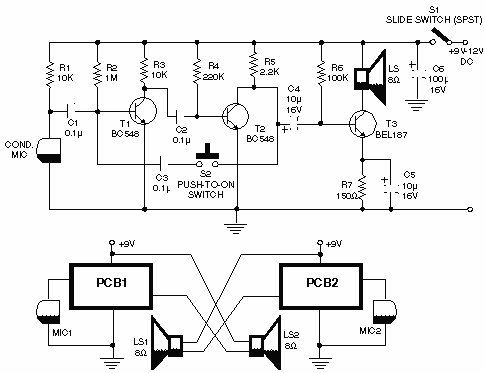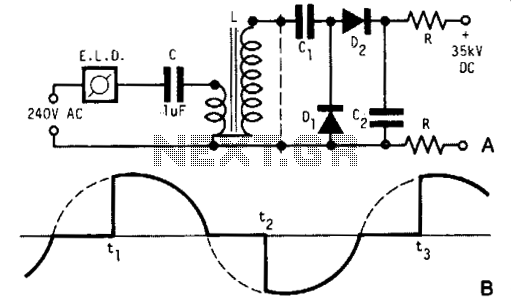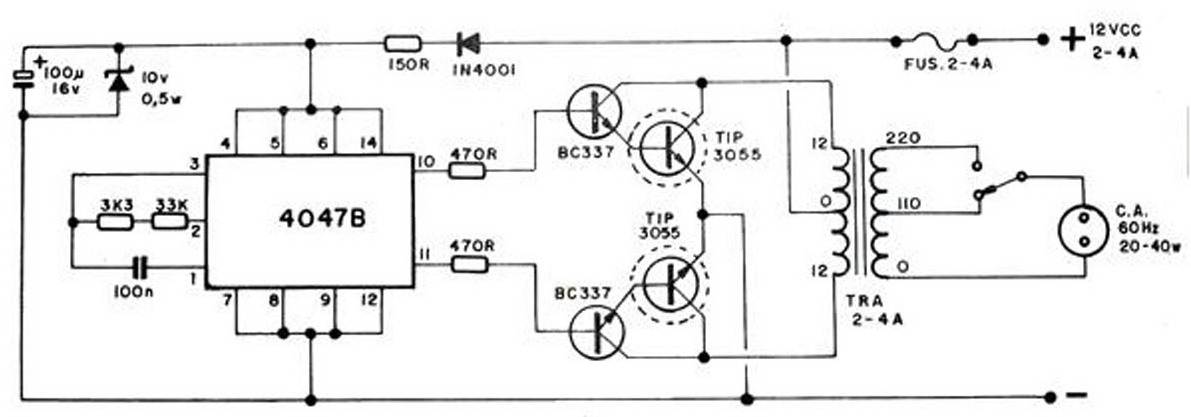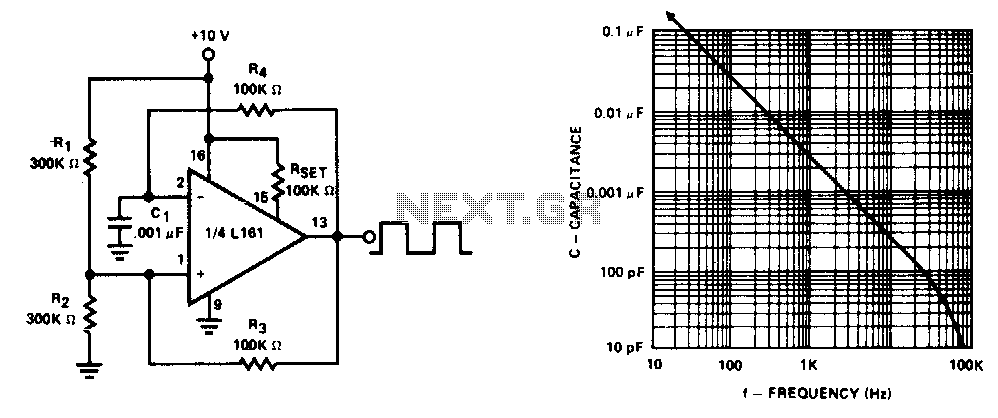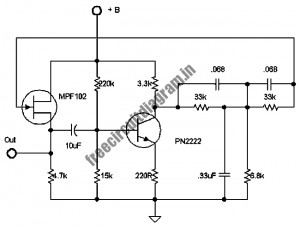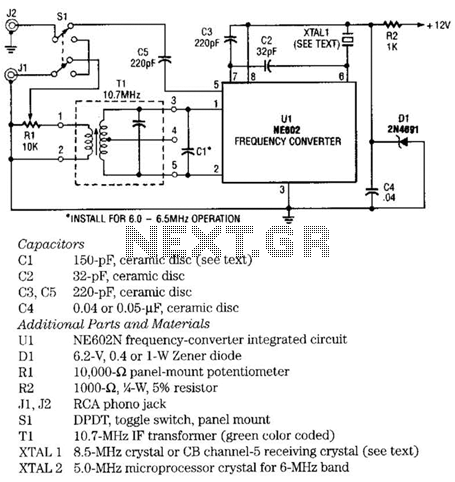
Simple Square Wave Generator Circuits
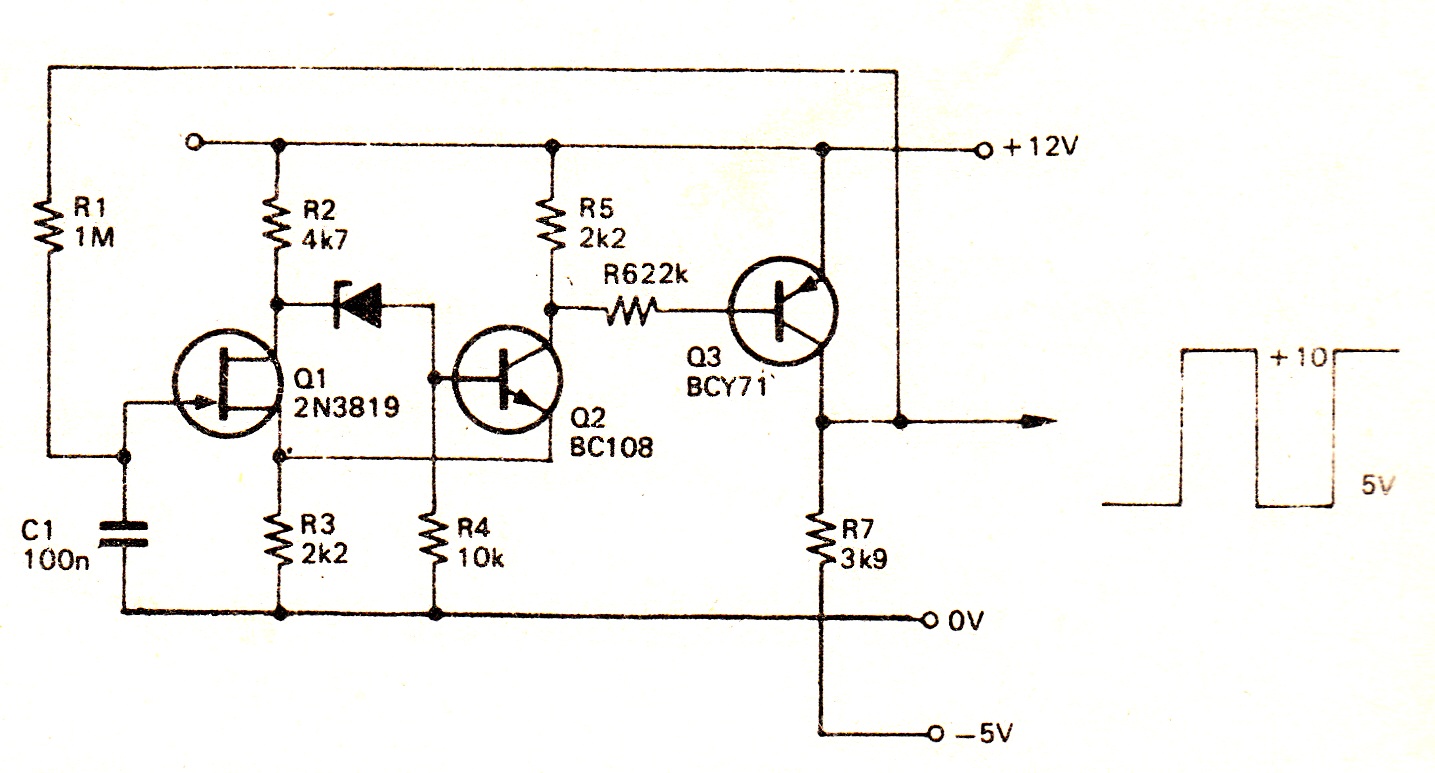
The circuit employs a field-effect transistor (FET) at the input of a Schmitt trigger, allowing the use of a low-value capacitor. The trigger, controlled by Q1 and O2, exhibits a hysteresis of approximately 3V, regulated by a 3V zener diode. When C1 is uncharged, O1 is off, and O2 is forward biased. The voltage at the source of Q1 is roughly +4V, enabling O2 to conduct and activate the transistor TR. Consequently, the output reaches +10V. Capacitor C1 charges through resistor R1, causing the gate voltage of Q1 to become positive. Once the gate voltage exceeds a certain threshold, Q1 conducts, turning off Q2. The positive feedback from the emitter of Q2 to the source of Q1 facilitates a rapid switch-off. Q3 also deactivates, resulting in the output dropping to -5V. Capacitor C1 then discharges towards -5V, and when the voltage across C1 decreases by about 3V, O1 stops conducting, turning on O2. The collector load of Q3 is connected to a negative supply, producing a 50% duty cycle. The circuit continues to oscillate if R7 is connected to ground, although the duty cycle will vary, with the output remaining at 0V for a longer duration than at +10V. With the specified components, the output frequency is approximately 0.025Hz. The LM3900N device, which contains multiple amplifiers, is well-suited for waveform generation at frequencies up to approximately 10 kHz. Additionally, voltage-controlled oscillators, where frequency is dependent on an input voltage, can be designed using this device. A simple square wave generator is illustrated, where capacitor Cn alternately charges and discharges between voltage limits set by resistors R2, R3, and R4. The circuit functions as a Schmitt trigger, with triggering voltages around Vt/3 and 2Vt/3. The time constant T of this circuit is defined as T = 0.7 R1C2, where T is in seconds, R1 is in ohms, and C2 is in farads. For instance, with R1 set to 10 kΩ and C2 at 100 microfarads, the time constant will be one second. Capacitor C2 can be selected from a wide range, and R1 may be a potentiometer with a maximum value of 100 kΩ. Outputs 1 and 2 generate pulses of opposite polarity; however, the rise time of output 2 is prolonged due to the charging current of C2.
The described circuit utilizes a field-effect transistor as the primary input element to a Schmitt trigger configuration, which provides enhanced noise immunity and a defined switching threshold. The hysteresis introduced by the combination of Q1 and O2 ensures stable operation by preventing false triggering due to noise or signal fluctuations. The integration of a 3V zener diode serves a critical role in regulating the voltage levels, allowing for precise control over the switching characteristics of the transistors involved.
The charging and discharging behavior of capacitor C1, governed by resistor R1, is pivotal in determining the oscillation frequency of the circuit. The time constant, given by the product of resistance and capacitance, dictates how quickly the capacitor can charge and discharge, thereby influencing the overall performance of the waveform generator. The LM3900N amplifiers are particularly advantageous for this application, as they can handle a variety of frequencies and facilitate the design of more complex oscillators.
The output characteristics, with a 50% duty cycle, are crucial for applications requiring precise timing signals. The ability to adjust the duty cycle by modifying R7 allows for flexibility in output signal behavior, accommodating different operational requirements. Furthermore, the use of a potentiometer for R1 provides additional tuning capabilities, enabling fine adjustments to the time constant and thereby the oscillation frequency.
The circuit's design also highlights the importance of feedback mechanisms in ensuring rapid transitions between states, which is essential for applications requiring sharp and reliable switching. The interaction between Q1, Q2, and Q3, facilitated by positive feedback, ensures that once the circuit transitions to a new state, it does so swiftly, minimizing the time spent in intermediate states that could lead to instability. Overall, this circuit exemplifies a robust approach to generating low-frequency square wave signals with adjustable characteristics, suitable for a range of electronic applications.Using a field effect transistor at the input of a schmitt trigger, means a low value capacitor can be employed. The trigger by Q1 and O2 has a hysteresis of approximately 3V. This is controlled by the 3V zenen Mth C1 uncharged O1 is off and O2 is forward biased. The voltage at the source of Q1 is approximately +4V. O2 conducts, thus turning on TR 3. The output is therefore at +1OV. C1 then charges via R1 and the gate voltage of Q1 goes positive. When the gate voltage is sufficiently positive Q1 conducts, turning off Q2. The positive feedback from the emitter of (12 to the source of (11 ensures a rapid switch off. Q3 also switches off and the output goes to -5V. Capacitor C1 now discharge towards -5V, but when the voltage across C1 falls by approximately 3V, Ol ceases to conduct, turning on 0. 2. The collector load of Q3 is connected to a negative supply giving a 50% duty cycle. (The circuit still oscillates if R7 is connected to GV but the duty cycle will change, the output remaining at OV for a longer period than at +10V).
With the components as shown the frequency of the output is approximately 0. 025Hz. The multiple amplifiers in the LM3900N device are very suitable for use ln waveform generators at frequencies of up to about 10 kHz. Voltage controlled oscillators (the frequency of which is dependent on an input voltage) can also be designed using the device.
A simple square wave generator is shown. The capacitor Cn alternately charges and discharges between voltage limits which are set by R2, R 3 and R4. The circuit is basically of the Schmitt trigger type, the voltages at which triggering occurs being approximately Vt/3 and 2V+/ 3.
The time constant T of this circuit is equal to 0. 7 R;C2. Where T is in seconds, R1 in ohms and C2 in farads. For example when R1 = 10 k and C2 = 100 microfareds the time constant will be one second. Capacitor C2 may be selected over wide a range and Ry may be a potentiometer 100 k maximum. Outputs 1_and 2 provide pulses of opposite polarity but the rise time of output 2is long due to the charging current of C2. 🔗 External reference
The described circuit utilizes a field-effect transistor as the primary input element to a Schmitt trigger configuration, which provides enhanced noise immunity and a defined switching threshold. The hysteresis introduced by the combination of Q1 and O2 ensures stable operation by preventing false triggering due to noise or signal fluctuations. The integration of a 3V zener diode serves a critical role in regulating the voltage levels, allowing for precise control over the switching characteristics of the transistors involved.
The charging and discharging behavior of capacitor C1, governed by resistor R1, is pivotal in determining the oscillation frequency of the circuit. The time constant, given by the product of resistance and capacitance, dictates how quickly the capacitor can charge and discharge, thereby influencing the overall performance of the waveform generator. The LM3900N amplifiers are particularly advantageous for this application, as they can handle a variety of frequencies and facilitate the design of more complex oscillators.
The output characteristics, with a 50% duty cycle, are crucial for applications requiring precise timing signals. The ability to adjust the duty cycle by modifying R7 allows for flexibility in output signal behavior, accommodating different operational requirements. Furthermore, the use of a potentiometer for R1 provides additional tuning capabilities, enabling fine adjustments to the time constant and thereby the oscillation frequency.
The circuit's design also highlights the importance of feedback mechanisms in ensuring rapid transitions between states, which is essential for applications requiring sharp and reliable switching. The interaction between Q1, Q2, and Q3, facilitated by positive feedback, ensures that once the circuit transitions to a new state, it does so swiftly, minimizing the time spent in intermediate states that could lead to instability. Overall, this circuit exemplifies a robust approach to generating low-frequency square wave signals with adjustable characteristics, suitable for a range of electronic applications.Using a field effect transistor at the input of a schmitt trigger, means a low value capacitor can be employed. The trigger by Q1 and O2 has a hysteresis of approximately 3V. This is controlled by the 3V zenen Mth C1 uncharged O1 is off and O2 is forward biased. The voltage at the source of Q1 is approximately +4V. O2 conducts, thus turning on TR 3. The output is therefore at +1OV. C1 then charges via R1 and the gate voltage of Q1 goes positive. When the gate voltage is sufficiently positive Q1 conducts, turning off Q2. The positive feedback from the emitter of (12 to the source of (11 ensures a rapid switch off. Q3 also switches off and the output goes to -5V. Capacitor C1 now discharge towards -5V, but when the voltage across C1 falls by approximately 3V, Ol ceases to conduct, turning on 0. 2. The collector load of Q3 is connected to a negative supply giving a 50% duty cycle. (The circuit still oscillates if R7 is connected to GV but the duty cycle will change, the output remaining at OV for a longer period than at +10V).
With the components as shown the frequency of the output is approximately 0. 025Hz. The multiple amplifiers in the LM3900N device are very suitable for use ln waveform generators at frequencies of up to about 10 kHz. Voltage controlled oscillators (the frequency of which is dependent on an input voltage) can also be designed using the device.
A simple square wave generator is shown. The capacitor Cn alternately charges and discharges between voltage limits which are set by R2, R 3 and R4. The circuit is basically of the Schmitt trigger type, the voltages at which triggering occurs being approximately Vt/3 and 2V+/ 3.
The time constant T of this circuit is equal to 0. 7 R;C2. Where T is in seconds, R1 in ohms and C2 in farads. For example when R1 = 10 k and C2 = 100 microfareds the time constant will be one second. Capacitor C2 may be selected over wide a range and Ry may be a potentiometer 100 k maximum. Outputs 1_and 2 provide pulses of opposite polarity but the rise time of output 2is long due to the charging current of C2. 🔗 External reference
